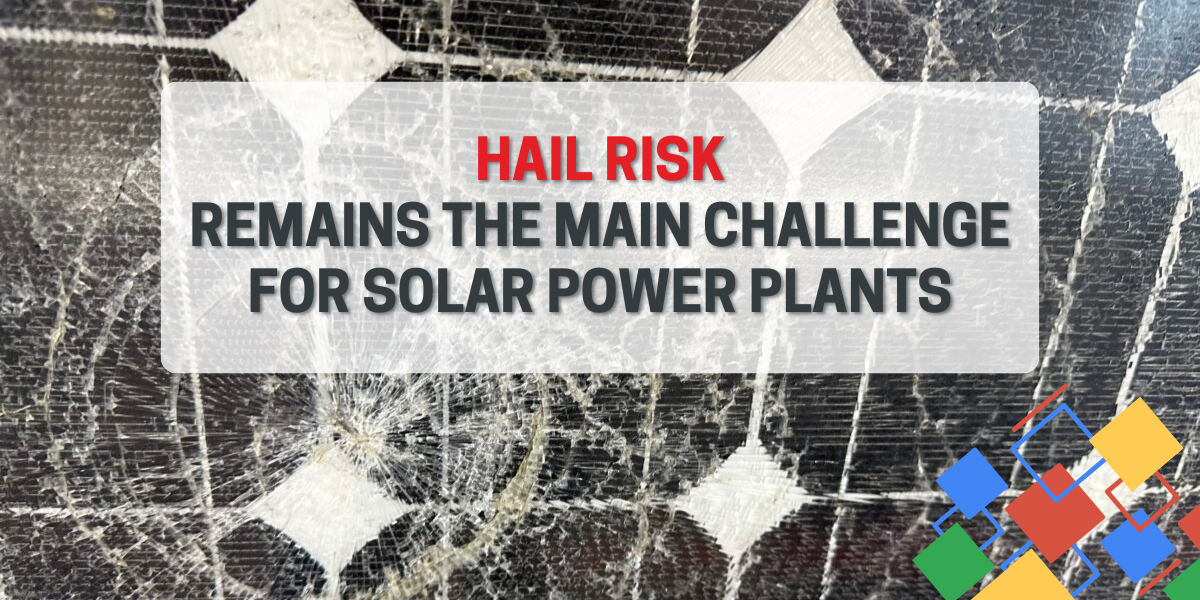News date: 26. 06. 2025.
Hail risk remains the main challenge for solar power plants

source: pv magazine
original article: Kennedy, R. (2025, 10. lipnja). Solar risks: Hail, AI error, wildfire, and more. PV Magazine USA
While solar energy continues to see strong growth in the U.S., accounting for over 50% of new planned electricity generation capacity in 2025, a new analysis reveals that physical and operational risks are increasingly threatening the sustainability of investments in solar power plants. The latest annual report by kWh Analytics, a company specializing in risk analysis for renewables, places hail at the top of the list of the most costly and unpredictable challenges faced by solar plant owners, writes PV Magazine USA.
Extreme Weather Conditions: Hail, Smoke, and Fires Threaten Production
Although hail accounts for only 6% of total incidents affecting solar installations, financially, the damages it causes make up nearly three-quarters of all losses due to weather-related events. Even more concerning is that significant damage is being recorded in regions that traditionally have not been prone to hail.

source: kWh Analytics
The risk is not just theoretical — research from Central Michigan University shows that nearly all solar installations in the U.S. face at least a 10% annual chance of hail with a diameter of 5 centimeters. Over a 25-year period, this risk becomes practically certain.
For this reason, the use of advanced systems for tilting modules into a protective position, double-glass modules, and more stable foundations is increasingly recommended. Real-world examples demonstrate that projects with proactive measures—such as those in Texas during the 2024 hailstorm—managed to avoid the catastrophic damage that affected neighboring installations.
Furthermore, it is recommended to use photovoltaic modules with double tempered glass—3.2 mm thick on the front and 2 mm on the back—instead of conventional modules with polymer backs. Studies have shown that the so-called glass/glass configuration offers significantly greater mechanical resistance—these modules can withstand impact loads up to 1.7 times higher compared to traditional glass/polymer designs. This construction not only increases the system’s durability in harsh environmental conditions but also contributes to the long-term reliability of the photovoltaic installation.
Risks don’t stop at hail. Smoke from wildfires, even when hundreds of kilometers away, can reduce annual production by about 6%. Increasing numbers of such fires are being recorded in the eastern and southern U.S., further expanding the risk zone for solar power plants.
Operational Challenges: Production Shortfalls, AI Errors, and Cyber Threats
In addition to weather-related threats, the report also highlights a range of operational issues. Analysis of tens of thousands of monthly data points from active power plants showed that systems, on average, produce 8.6% less energy than predicted by financial models.
The causes are numerous — from reduced energy drawn from the grid and technical losses to overly optimistic performance models during the design phase, often driven by unrealistic financial expectations.
There is also a concerning sharp increase in cyberattacks on the energy sector — with a 70% rise recorded in 2024. As solar plants and battery systems increasingly rely on digital monitoring and control systems, their exposure to hacking threats grows.
On the technical side, there is also a rise in so-called “hot spots” — localized overheating on modules — which can cause losses of up to 30% per module and accelerate the degradation of system functionality. Modules with half-cells are most affected, especially if the system design is technically mismatched.

source: Zeitview / kWh Analytics
Another challenge is the accuracy of predictions — performance models rarely account for long-term climate changes. Research shows that shifts in temperature and precipitation could reduce the efficiency of solar systems by nearly 5% over the long term.
Additionally, it is particularly concerning that tested “out-of-the-box” AI algorithms incorrectly identified the cause of degradation and damage from weather-related events in 40 to 50% of cases — directly impacting the reliability assessments and maintenance planning of photovoltaic systems.
Insurance for solar installations: a key protection against hail risk
In conditions of increasingly frequent extreme weather events, insuring solar power plants against hail risk becomes an indispensable element of managing infrastructure and financial risks. Photovoltaic modules, as the most exposed part of the system, are the first to be hit by hail, which can cause glass cracks, microcracks within the cells, and consequently reduced efficiency and permanent system degradation. Considering the high value of the equipment and the expected lifespan of the system of 20 or more years, failing to insure the system represents a serious business oversight. Quality insurance policies cover not only material damages but also production losses, remediation costs, and potential liabilities to third parties, which is especially important for grid-connected systems that generate revenue or ensure self-consumption. Furthermore, in projects financed through loans or leasing, banks regularly require adequate insurance as a prerequisite for fund approval. Ultimately, investing in insurance for a solar power plant is not just financial protection — it is a strategic measure that ensures production stability, investment preservation, and business continuity in the renewable energy sector.


